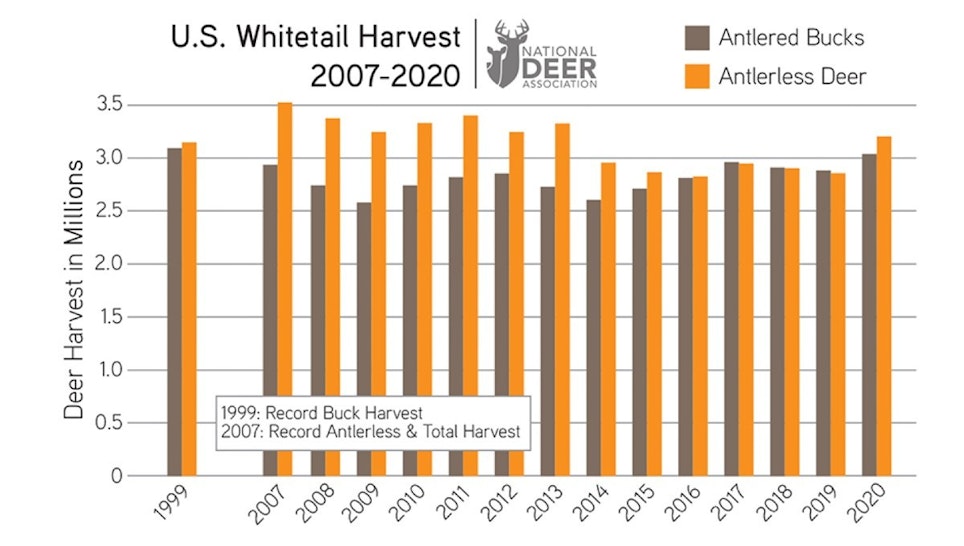
This South Dakota 4x4 is one of more than 3 million bucks tagged by deer hunters across the country in 2020. This is the most bucks taken during one season since 1999.
According to the National Deer Association’s latest Deer Report, hunters killed an estimated 6.3 million whitetails during the 2020 hunting season, which is the most since 2011 (see chart below). The report showed that harvest numbers of antlered bucks and antlerless deer were up over the 2019 season. The headline, however, is this: The estimated buck harvest of 3,041,544 in 2020 was the most since 1999.
“2020 saw the highest buck harvest in the new century, and amazingly we estimate that we set another new record for the percentage of those bucks that were 3.5 years old or older,” said NDA Chief Conservation Officer Kip Adams. “U.S. hunters are taking fewer yearling bucks and killing more of them as mature deer, but this doesn’t mean fewer bucks harvested overall. We’re killing older bucks and more bucks than ever in America.”
Adams says that the steadily climbing percentage of 3.5-and-older bucks in the harvest (see chart below) is the result of declining pressure nationwide on yearling bucks (1.5 years old). Only 26% of the 2020 antlered buck harvest was yearlings, a new record low in modern history. The total buck harvest of 3,041,544 in 2020 was up 5.3% from the previous season; it is estimated 41% of them were 3.5 or older, or 1.2 million.

The change in hunting pressure on yearling bucks is clear when you look at the numbers from 1999. Compared to 2020, deer hunters killed slightly more bucks in total in the record 1999 season. However, that 1999 harvest included more than 50% yearlings, compared to only 26% during 2020.
In my opinion, while minimum antler point restrictions put into place in some states during the past 2 decades are responsible for some of this change, the primary reason is hunter attitude. The “brown is down” mantra isn’t as common today as it was 20 years ago. And with many states offering bonus antlerless-only tags, hunters can pass on yearling bucks in hopes they encounter an older buck, while filling their freezer with a doe.
The new Deer Report covers data for the entire 2020-21 hunting season, the most recent season with complete harvest data available from all major deer states. Click here for a copy of the report.
“To collect the data for our annual Deer Report, we conduct a survey of each state wildlife agency’s deer project leader,” Adams said. “They provide us the harvest data and age structure of the harvest. Each state collects that data a little differently, but we use the data they submit. See page 18 in our 2020 Deer Report for a state-by-state list of how they collect it.”
More facts from the latest Deer Report:
- 65% of deer taken in the 2020-21 season were killed with a firearm compared to 26% with archery equipment and 9% with a muzzleloader.
- Texas had the highest total buck harvest of any state at 449,933, but Alabama had the greatest increase in buck harvest from the previous season of any state, climbing by more than 27,000.
- Delaware increased its buck harvest by the greatest percentage of any state with 57%, and Delaware also took over the top spot in buck harvest per square mile, at 3.9.
- Mississippi killed the most bucks per 100 hunters at 74.






